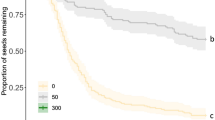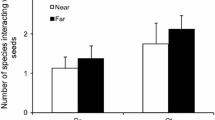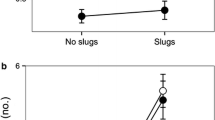Abstract
Strong interactions between dry-fruited shrubs and seed-harvesting ants are expected in early successional scrubs, where both groups have a major presence. We have analysed the implications of the seed characteristics of two dry-fruited shrub species (Coronilla minima and Dorycnium pentaphyllum) on seed predation and dispersal mediated by harvester ants and the consequences of these processes on spatio-temporal patterns of plant abundance in a heterogeneous environment. We found that large C. minima seeds were collected much more (39%) than small D. pentaphyllum seeds (2%). However, not all of the removed seeds of these plant species were consumed, and 12.8% of the seeds were lost along the trails, which increased dispersal distances compared with abiotic dispersal alone. Seed dropping occurred among all microhabitats of the two plant species, but especially in open microhabitats, which are the most suitable ones for plant establishment. The two plant species increased their presence in the study area during the study period: C. minima in open microhabitats and D. pentaphyllum in high vegetation. The large size of C. minima seeds probably limited the primary seed dispersal of this species, but may have allowed strong interaction with ants. Thus, seed dispersal by ants resulted in C. minima seeds reaching more suitable microhabitats by means of increasing dispersal distance and redistribution among microhabitats. In contrast, the smaller size of D. pentaphyllum seeds arguably allows abiotic seed dispersal over longer distances and colonization of all types of microhabitats, although it probably also limits their interaction with ants and, consequently, their redistribution in suitable microhabitats. We suggest that dyszoochory could contribute to the success of plant species with different seed characteristics in scrub habitats where seeds are abundantly collected by seed-harvesting ants.





Similar content being viewed by others
References
Andersen AN (1987) Effects of seed predation by ants on seedling densities at a woodland site in SE Australia. Oikos 48:171–174
Andersen AN (1988) Immediate and longer-term effects of fire on seed predation by ants in sclerophyllous vegetation in south-eastern Australia. Aust J Ecol 13:285–293
Andersen AN (1989) How important is seed predation to recruitment in stable populations of long-lived perennials? Oecologia 81:310–315
Andersen AN, Azcárate FM, Cowie ID (2000) Seed selection by an exceptionally rich community of harvester ants in the Australian seasonal tropics. J Anim Ecol 69:975–984
Arnan X, Rodrigo A, Molowny-Horas R, Retana J (2010) Ant-mediated expansion of an obligate seeder species during the first years after fire. Plant Biol 12:842–852
Aronne G, Wilcock CC (1994) Reproductive characteristics and breeding system of shrubs of the Mediterranean region. Funct Ecol 8:69–76
Azcárate FM, Arqueros L, Sánchez AM, Peco B (2005) Seed and fruit selection by harvester ants, Messor barbarus, in Mediterranean grassland and scrubland. Funct Ecol 19:273–283
Baskin JM, Baskin CC (1989) Physiology of dormancy and germination. In: Leck MA, Palmer VT, Simpson RL (eds) Ecology of soil seed banks. Academic Press, San Diego, pp 53–66
Battaglia LL, Foré SA, Sharitz RR (2000) Seedling emergence, survival and size in relation to light and water availability in two bottomland hardwood species. J Ecol 88:1041–1050
Beattie AJ (1985) The evolutionary ecology of ant-plant mutualisms. Cambridge University Press, Cambridge
Blate GM, Peart DR, Leighton M (1998) Post-dispersal predation on isolated seeds: a comparative study of 40 tree species in a southeast Asian rainforest. Oikos 82:522–538
Boulay R, Carro F, Soriguer RC, Cerdá X (2009) Small-scale indirect effects determine the outcome of a tripartite plant–disperser–granivore interaction. Oecologia 161:529–537
Boyd RS (1996) Ant-mediated seed dispersal of the rare chaparral shrub Fremontodendron decumbens (Sterculiaceae). Madroño 43:299–315
Brown MJF, Human KG (1997) Effects of harvester ants on plant species distribution and abundance in a serpentine grassland. Oecologia 112:237–243
Brown JH, Reichman OJ, Davidson DW (1979) Granivory in desert ecosystems. Annu Rev Ecol Syst 10:201–227
Cerdan P (1989) Etude de la Biologie, de l’Ecologie et du Comportament des Fourmis Moissonneuses du Genre Messor (Hymenoptera, Formicidae) en Crau. PhD thesis. Université de Provence, Marseille
Coomes DA, Grubb PJ (2003) Colonization, tolerance, competition and seed-size variation within functional groups. Trends Ecol Evol 18:283–291
Crist TO, MacMahon JA (1992) Harvester ant foraging and shrub-steppe seeds: interactions of seed resources and seed use. Ecology 73:1768–1779
Crist TO, Wiens JA (1994) Scale effects of vegetation on forager movement and seed harvesting by ants. Oikos 69:37–46
Davison EA (1982) Seed utilization by harvester ants. In: Buckley RC (ed) Ant–plant interactions. Dr W Junk Publishers, The Hague, pp 1–6
de Bolós O, Vigo J, Masalles RM, Ninot JM (1993) Flora manual dels Països Catalans, 2nd edn. Editorial Pòrtic, Barcelona
Detrain C, Pasteels JM (2000) Seed preferences of the harvester ant Messor barbarus in a Mediterranean mosaic grassland (Hymenoptera: Formicidae). Sociobiology 35:35–48
Detrain C, Tasse O (2000) Seed drops and caches by the harvester ant Messor barbarus: do they contribute to seed dispersal in Mediterranean grasslands? Naturwissenschaften 87:373–376
Detrain C, Tasse O, Versaen M, Pasteels JM (2000) Seed preferences of the harvester ant Messor barbarus in a Mediterranean mosaic grassland. Sociobiology 35:35–48
Eriksson O (2005) Game theory provides no explanation for seed size variation in grasslands. Oecologia 144:98–105
Eriksson O, Ehrlén J (1992) Seed and microsite limitation of recruitment in plant populations. Oecologia 91:360–364
Gorb SN, Gorb EV (1999) Dropping rates of elaiosome-bearing seeds during transport by ants (Formica polyctena Foerst.): implications for distance dispersal. Acta Oecol 20:509–518
Gorb EV, Gorb SN (2000) Effects of seed aggregation on the removal rates of elaiosome-bearing Chelidonium majus and Viola adourata seeds carried by Formica polyctena ants. Ecol Res 15:187–192
Guarino R, Ferrario B, Mossa L (2005) A stochastic model of seed dispersal pattern to assess seed predation by ants in annual dry grasslands. Plant Ecol 178:225–235
Harper JL (1977) Population biology of plants, 1st edn. Academic Press, London
Herrera CM (1984) Tipos morfológicos y funcionales en plantas del matorral mediterráneo del sur de España. Stud Oecol 5:7–34
Hölldobler B, Wilson EO (1990) The ants, 1st edn. Springer, Berlin Heidelberg New York
Hoppes WG (1988) Seedfall pattern of several species of bird-dispersed plants in an Illinois woodland. Ecology 69:320–329
Howe HF, Brown JS (2001) The ghost of granivory past. Ecol Lett 4:371–378
Hughes L, Westoby M (1990) Removal rates of seeds adapted for dispersal by ants. Ecology 71:138–148
Hulme PE (1997) Post-dispersal seed predation and the establishment of vertebrate dispersed plants in Mediterranean scrublands. Oecologia 111:91–98
Hulme PE (1998) Post-dispersal seed predation: consequences for plant demography and evolution. Perspect Plant Ecol Evol Syst 1:32–46
Janzen DH (1971) Seed predation by animals. Annu Rev Ecol Syst 2:465–492
Jordano P, Herrera CM (1995) Shuffling the offspring: uncoupling and spatial discordance of multiple stages in vertebrate seed dispersal. Ecoscience 2:230–237
Kunin WE (1994) Density-dependent foraging in the harvester ant Messor ebeninus: two experiments. Oecologia 98:328–335
Levey DJ, Byrne MM (1993) Complex ant–plant interactions: rain forest ants as secondary dispersers and post-dispersal seed predators. Ecology 74:1802–1812
Louda SM (1982) Distribution ecology: variation in plant recruitment over a gradient in relation to insect seed predation. Ecol Monogr 52:25–41
MacMahon JA, Mull JF, Crist TO (2000) Harvester ants (Pogonomyrmex spp.): their community and ecosystem influences. Annu Rev Ecol Syst 31:265–291
Moles AT, Westoby M (2004) Seedling survival and seed size: a synthesis of the literature. J Ecol 92:372–383
Moore KA, Elmendorf SC (2006) Propagule vs. niche limitation: untangling the mechanisms behind plant species’ distributions. Ecol Lett 9:797–804
Morehead SA, Feener DH (1998) Foraging behavior and morphology: seed selection in the harvester ant genus, Pogonomyrmex. Oecologia 114:548–555
Münzergová Z, Herben T (2005) Seed, dispersal, microsite, habitat and recruitment limitation: identification of terms and concepts in studies of limitations. Oecologia 145:1–8
O’Dowd DJ, Hay ME (1980) Mutualism between harvester ants and a desert ephemeral: seed escape from rodents. Ecology 61:531–540
Ohkawara K, Higashi S, Ohara M (1996) Effects of ants, ground beetles and the seed-fall patterns on myrmecochory of Erythronium japonicum Decne. (Liliaceae). Oecologia 106:500–506
Ordoñez JL, Retana J (2004) Early reduction of post-fire recruitment of Pinus nigra by post-dispersal seed predation in different time-since-fire habitats. Ecography 27:449–458
Ordoñez JL, Retana J, Espelta JM (2004) Limitation of the recruitment of Pinus nigra in a gradient of post-fire environmental conditions. Ecoscience 11:296–304
Ostfeld RS, Mason RH, Canham CD (1997) Effects of rodents on tree invasion of old fields. Ecology 78:1531–1542
Passos L, Oliveira PS (2002) Ants affect the distribution and performance of seedlings of Clusia criuva, a primarily bird-dispersed rain forest tree. J Ecol 90:517–528
Reader RJ (1993) Control of seedling emergence by ground cover and seed predation in relation to seed size for some old-field species. J Ecol 81:169–175
Reichman OJ (1979) Desert granivore foraging and its impact on seed densities and distributions. Ecology 60:1085–1092
Retana J, Picó FX, Rodrigo A (2004) Dual role of harvesting ants as seed predators and dispersers of a non-myrmecochorous Mediterranean perennial herb. Oikos 105:377–385
Rey PJ, Garrido JL, Alcántara JM, Ramírez JM, Aguilera A, García L, Manzaneda AJ, Fernández R (2002) Spatial variation in ant and rodent post-dispersal predation of vertebrate-dispersed seeds. Funct Ecol 16:773–781
Reyes-López JL, Fernández-Haeger J (2001) Some factors determining size-matching in the harvester ant Messor barbarus: food type, transfer activity, recruitment rate and size-range. Insectes Soc 48:118–124
Sallabanks RS (1992) Fruit fate, frugivory, and fruit characteristics: a study of the hawthorn, Crataegus monogyna (Rosaceae). Oecologia 91:296–304
Schöning C, Espadaler X, Hensen I, Roces F (2004) Seed predation of the tussock-grass Stipa tenacissima L. by ants (Messor spp.) in south-eastern Spain: the adaptive value of trypanocarpy. J Arid Environ 56:43–61
Schupp EW (1995) Seed-seedling conflicts, habitat choice, and patterns of plant recruitment. Am J Bot 82:399–409
Thompson K, Band SR, Hodgson JG (1993) Seed size and shape predict persistence in soil. Funct Ecol 7:236–241
Vander Wall SB, Kuhn KM, Beck MJ (2005) Seed removal, seed predation, and secondary dispersal. Ecology 86:801–806
Wang BC, Smith TB (2002) Closing the seed dispersal loop. Trends Ecol Evol 17:379–385
Westoby M, Falster DS, Moles AT, Vesk PA, Wright IJ (2002) Plant ecological strategies: some leading dimensions of variation between species. Annu Rev Ecol Syst 33:125–159
Wilby A, Shachak M (2000) Harvester ant response to spatial and temporal heterogeneity in seed availability: pattern in the process of granivory. Oecologia 125:495–503
Willott SJ, Compton SG, Incoll LD (2000) Foraging, food selection and worker size in the seed harvesting ant Messor bouvieri. Oecologia 125:35–44
Willson MF (1992) The ecology of seed dispersal. In: Fenner M (ed) Seeds: the ecology of regeneration in plant communities. CAB International, Wallingford, pp 61–85
Zavala MA, Espelta JM, Retana J (2000) Constraints and trade-offs in Mediterranean plant communities: the case of holm oak-aleppo pine forests. Bot Rev 66:119–149
Acknowledgments
We are very grateful to Helena Barril for field assistance and Jacqueline Minett for the correction of the English. This research was partly funded by CICYT project REN2001-2500/GLO, by the CONSOLIDER INGENIO project CSD 2008-0040 and by the Departament d’Universitats, Recerca i Societat de la Generalitat de Catalunya grant 2002 FI 00095 to X. Arnan. All experiments comply with the Spanish current laws.
Author information
Authors and Affiliations
Corresponding author
Additional information
Communicated by Jacqui Shykoff.
Rights and permissions
About this article
Cite this article
Arnan, X., Rodrigo, A. & Retana, J. What are the consequences of ant–seed interactions on the abundance of two dry-fruited shrubs in a Mediterranean scrub?. Oecologia 167, 1027–1039 (2011). https://doi.org/10.1007/s00442-011-2034-9
Received:
Accepted:
Published:
Issue Date:
DOI: https://doi.org/10.1007/s00442-011-2034-9




